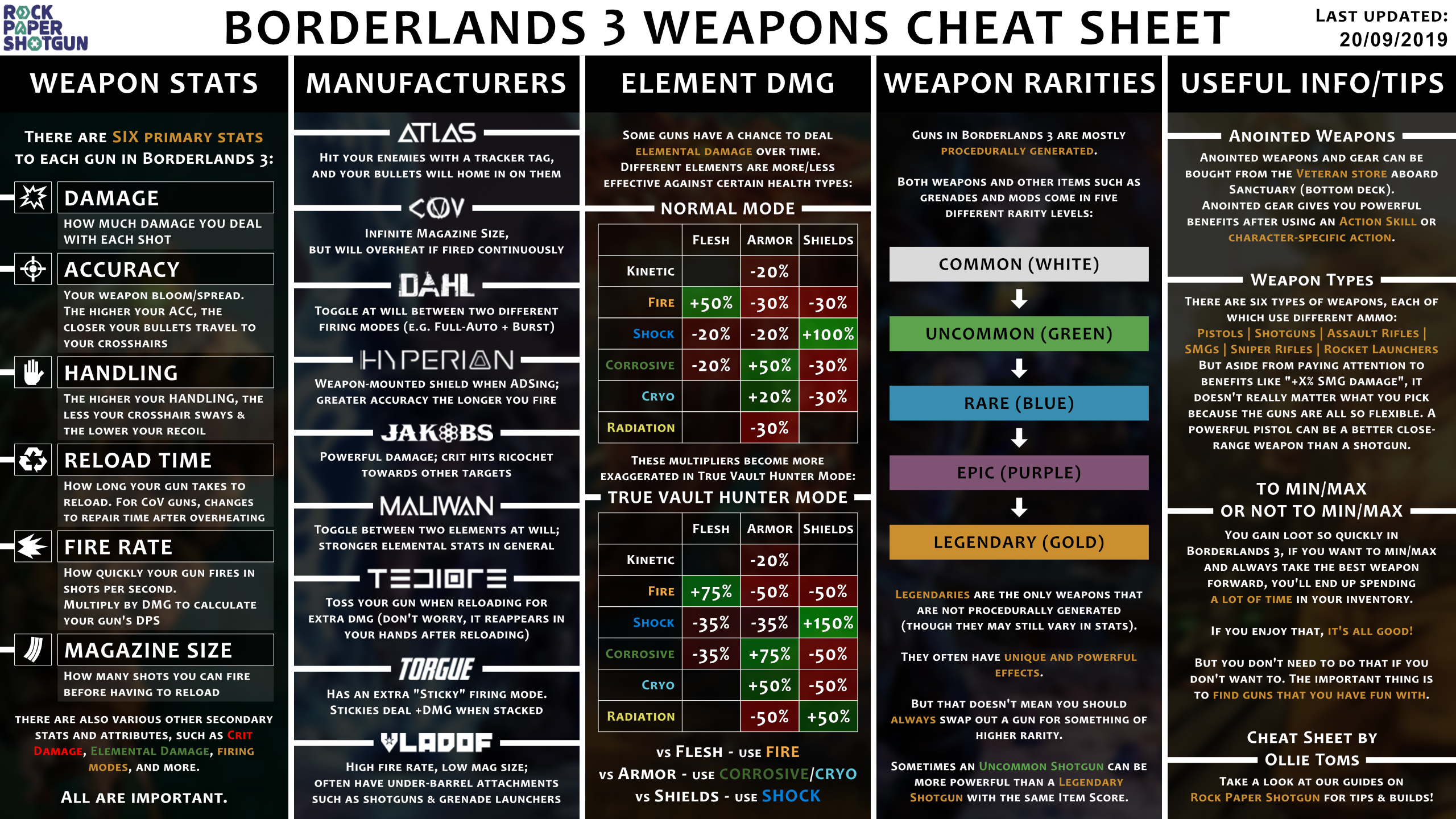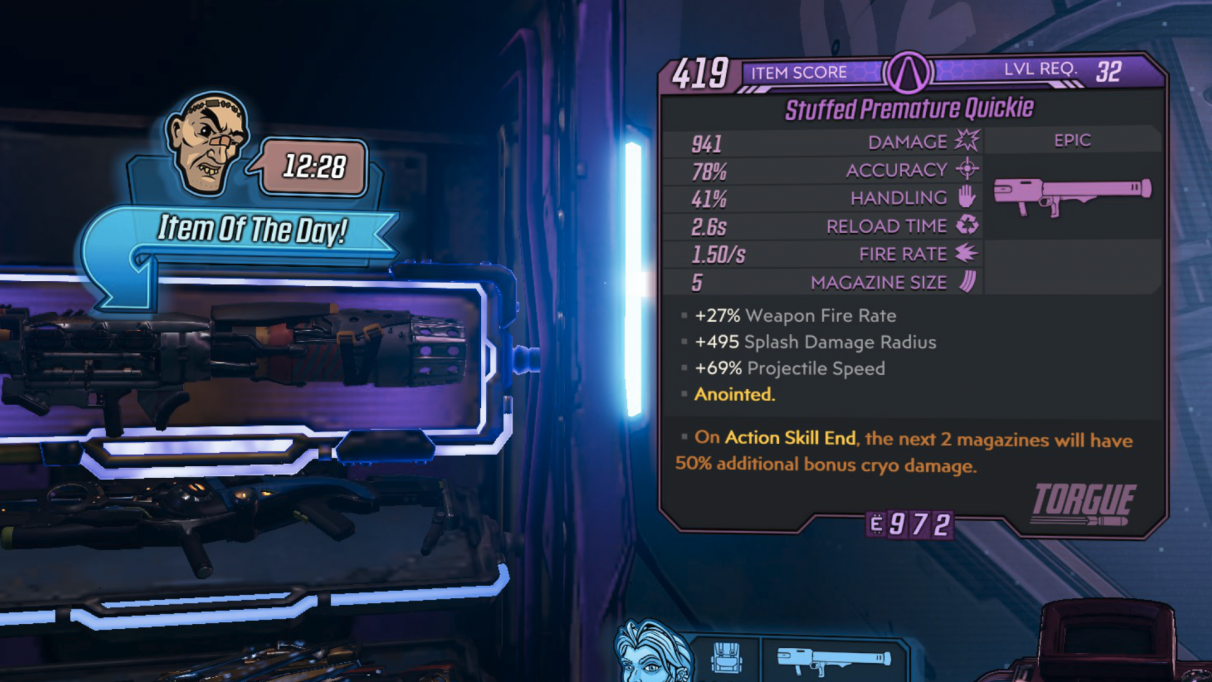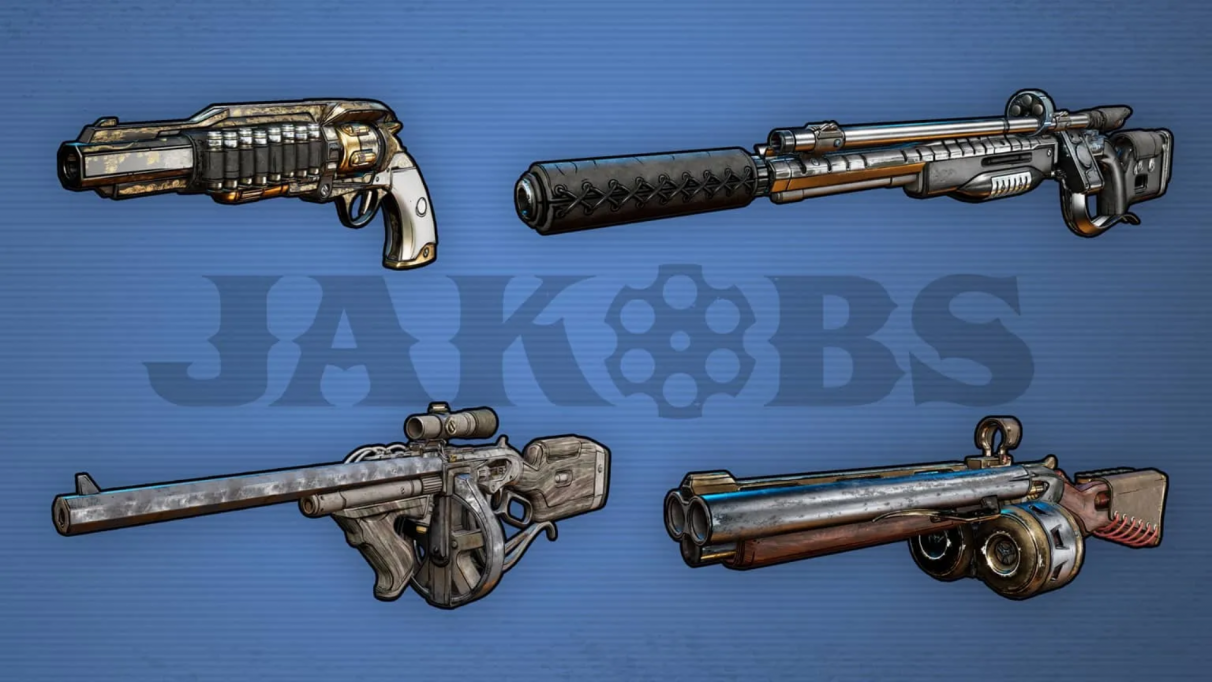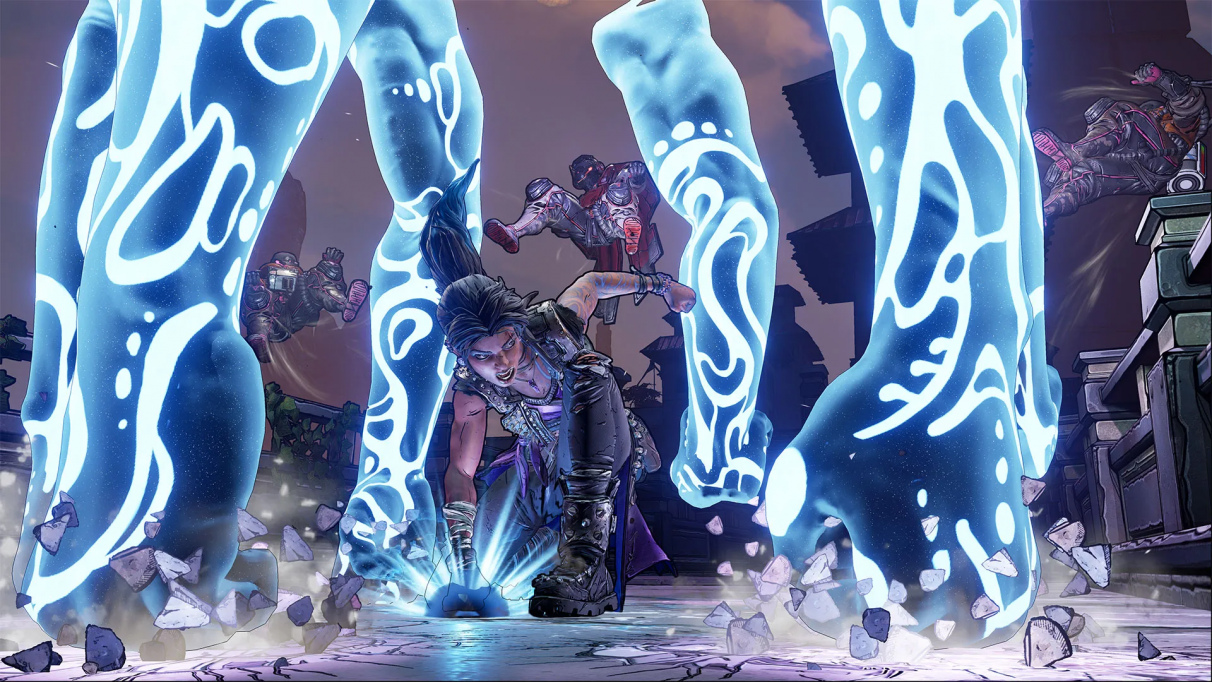Borderlands 3 weapons guide - overview Borderlands cheat sheet (2560x1440) Borderlands 3 Anointed weapons & gear Borderlands 3 weapon stats & rarities explained Borderlands 3 weapon types & manufacturers Borderlands 3 elemental damage
Borderlands 3 weapons guide - overview
Borderlands 3 will send as many guns flying your way as bullets throughout its campaign and beyond. Boasting too many guns to even try to put a number on, the game actually has a great many different interconnecting systems that work together to procedurally generate unique loot for you on the fly. Some of these systems include:
Weapon types - there are six different weapon types to choose from, ranging from close-range, slow-firing Shotguns to blisteringly fast SMGs and long-range sniper rifles; Weapon Manufacturers - the nine different weapons manufacturers in Borderlands 3 each offer different benefits for using their guns; Rarities - the loot and weapons you find will always be in one of five colours or rarities, from Common all the way up to Legendary; Elemental damage - there are various different types of damage that you can use to increase your damage against certain types of targets, whether they’re clad in shields, armor, or just heaps of flesh; Anointed weapons - certain weapons are Anointed, which means they have special effects of benefits that activate when you use an Action Skill or character-specific action.
The point is that there are a great many more things to take into account every time you find a new weapon than just the base stats alone. But hopefully the below cheat sheet will make that whole process a hell of a lot easier for you!
Borderlands weapons cheat sheet of stats & tips
Above is the pièce de résistance of our Borderlands 3 weapons guide: a fully up-to-date, 2560x1440 resolution Borderlands 3 cheat sheet, filled from head to foot with the most useful information on all of the interconnected systems that make the Borderlands weapons what they are:
Weapon Stats covers the six primary stats for each Borderlands 3 weapon and what they do; Manufacturers explains all of the weapon manufacturers and how their guns differ from the rest; Element DMG gives you detailed information on elemental damage (which you can also find below); Weapon Rarities goes over the five different colours/rarities which you can find Borderlands 3 guns in; And finally, Useful Info/Tips is where I’ve added smaller but equally useful tidbits on Anointed weapons, weapon types, and more.
To view this sheet in full 2k resolution, simply click on it once to expand the image, and then right-click and select “View Image”. Enjoy!
Borderlands 3 Anointed weapons and gear
Certain weapons in Borderlands 3 are what’s called Anointed weapons. Until you reach the Borderlands 3 Endgame content, your only chance to acquire Anointed gear is to purchase them for Eridium at Crazy Earl’s Veteran Store vending machine on the bottom deck of your ship, Sanctuary. Borderlands 3 characters & skill trees - Read this guide to learn all about how the characters and classes work! Borderlands 3 Amara build guide - Try out these top-tier builds to turn Amara into a true God-Queen! Borderlands 3 FL4K build guide - Make the most of your time with the Beastmaster and their loyal pets! Borderlands 3 Moze build guide - Kit Moze and her Iron Bear Mech with these fantastically destructive builds! Borderlands 3 Zane build guide - Zane’s flexibility leads to some fantastic builds; here are our favourites! If a weapon is Anointed, it means you gain a special benefit or effect when/after you use an Action Skill, or in certain cases another character-specific ability/action. For instance, one might read “On Action Skill End, the next two magazines will have 50% additional bonus corrosive damage”. Some Anointed weapons are specific to a certain class or character. These will say “Anointed Beastmaster”, “Anointed Gunner”, “Anointed Operative”, or “Anointed Siren” in the description instead of just “Anointed”. Many of these character-specific Anointed weapons will activate their special effect only upon a specific Action Skill, for example Amara’s Phasecast, or Zane’s Digi-Clone. Anointed weapons can have very powerful effects, but it’s important also to pay attention to whether the weapons themselves would be decent if you took away the Anointed effect. It’s also a good idea to look for Anointed effects which match well with the weapon type or role. For example, in order to make the most of an Anointed perk that increases your weapon damage by 300% after using your Action Skills, you’ll need that weapon to have a high DPS in the first place. If that’s not the case, it might not be worth picking up that particular Anointed weapon.
Borderlands 3 weapons stats & rarities explained
Borderlands 3 guns are defined, first and foremost, by six primary stats:
Damage - How much damage you deal with each shot (sometimes written in the form of AxB, where A is the damage and B is the number of individual bullets fired with each pull of the trigger) Accuracy - This controls your weapon bloom, or spread. High Accuracy means your bullets will closely follow the path of your crosshair, while low Accuracy means your bullets are fired more inaccurately. Think of it like a cone heading out from your gun: higher accuracy narrows this cone, making your shots more likely to hit your target. Handling - Affects both your weapon kickback/recoil after firing, and the amount of weapon sway you must deal with while aiming. Reload Time - How long your gun takes to reload. For Children of the Vault (CoV) weapons, which have infinite magazine size but overheat if fired for too long, this stat changes to Repair Time after overheating. Fire Rate - How many shots your gun fires every second. Multiply this value by your Damage stat in order to work out the gun’s Damage Per Second (DPS). Magazine Size - How many shots you can fire before having to reload.
Guns are also divided into different colours or rarities, ranging from Common (White) to Uncommon (Green) to Rare (Blue) to Epic (Purple) to Legendary (Gold). Yes, exactly like Fortnite. But unlike Fortnite, it doesn’t matter too much what the rarity of a gun is in Borderlands 3. Many times now, I’ve seen an Epic or even Legendary weapon completely outclasses (at least from a DPS perspective) by a Common or Uncommon weapon of around the same item score (or even less). The only rarity you should really pay attention to are the Legendaries - these guns are the only ones in the game that are not procedurally generated, but stay the same for each player (albeit with slight stat differences). Check out our Borderlands 3 Legendary weapons guide for tonnes more info on the very best Legendary weapons you can find during your travels!
Borderlands 3 weapons - types & manufacturers
There are six different types of guns in Borderlands 3, each of which take a different type of ammunition. These types are: Shotguns, Pistols, Assault Rifles, Submachine Guns (SMGs), Sniper Rifles, and Rocket Launchers. They all by and large fulfil the role you’d expect: Shotguns are generally for high close range damage, while Sniper Rifles are great for long-range sharpshooting and crits. Assault Rifles are versatile at most ranges, SMGs have a high fire rate and are best at closer range… You get the idea. But because of how random and crazy the procedural generation of guns is in Borderlands 3, you’ll often find exceptions to this rule. In my experience, pistols in particular are far better close-range weapons than shotguns. I’m talking specifically about the revolver-type pistols, the ones with high damage and a blistering rate of fire but only 4-6 shots in your magazine. Often, these 4-6 shots deal far more damage per second overall than even the most fantastic shotguns. A lot of this also comes down to the weapon manufacturers. There are nine manufacturers or brands in total, and each one focuses on a different mechanic or aspect of gunplay:
Atlas weapons have an alt-fire mode which tags your targets with trackers. Your main firing mode will shoot bullets that home in on tracked targets. CoV (Children of the Vault) weapons have an infinite magazine size and thus never have to be reloaded. However, they will overheat if fired for too long. DAHL weapons can toggle between two different firing modes (for example, Full-Auto and Burst), making them very versatile guns. Hyperion weapons give you a weapon-mounted shield to protect you while aiming down sights; and their guns gain increased Accuracy the longer you hold down the trigger. Jakobs weapons go down the direct damage route. They reward critical hits with ricochet shots that bounce towards additional targets. Maliwan weapons are kings of the elements: their elemental effects deal more damage and have a higher chance of activating than most other weapons, and you can toggle between two different elements at will. Tediore weapons allow you to throw your weapon at the enemy instead of reloading! The gun will explode or bounce between enemies dealing extra damage, before rematerialising in your hands a moment later. Torgue weapons all have a “sticky” alt-fire mode which fires projectiles which stick onto targets or surfaces and explode after a few moments. Stacking multiple “stickies” on the same target will cause them to deal increased damage upon detonation. Vladof weapons boast the highest fire rates but suffer from low magazine sizes. They also often have under-barrel attachments that cross into different weapon types, such as Shotguns and Grenade Launchers.
Borderlands 3 elemental damage
Elements are a very important aspect of damage-dealing in Borderlands 3, as they were in previous Borderlands titles as well. There are six different damage types available to both you and your enemies, and each of them deal differing amounts of damage based on the target’s health type (Flesh, Armor, or Shields):
Kinetic damage (or Normal damage) deals normal damage to everything but -20% damage to Armor. Fire/Incendiary damage deals +50% damage to Flesh, but -30% damage to Armor/Shields. Fire can also Ignite enemies to kill them. Shock damage deals +100% damage to Shields, but -20% damage to Flesh/Armor. Shock can also Electrocute enemies to kill them. Corrosive damage deals +50% damage to Armor, but -20% damage to Flesh and -30% to Shields. Corrosive can also Melt enemies to kill them. Cryo damage deals +20% damage to Armor but normal damage to Flesh and -30% damage to Shields. Cryo can also slow enemies until they Freeze. Radiation damage deals normal damage to Flesh and Shields but -30% damage to Armor. However, targets hit by Radiation damage will also damage enemies around them over time.
Thinking ahead about the enemies you are about to face and picking your elements accordingly may have a substantial effect on the outcome of your fights. Having said that, the vast majority of enemies you will face have neither Shields nor Armor, so Fire/Incendiary damage is probably the most useful element to keep with you on average.
And with that, I’m gonna wrap up this Borderlands 3 weapons guide. Hopefully this guide (and its associated cheat sheet - did I mention it was in 2k resolution?) have cleared up a few things, and answered a few questions you perhaps had on the vast interconnecting systems permeating each gun and weapon in Borderlands. But if not - feel free to pop your question below in the comments and I (or possibly one of the other Borderlands-savvy RPS crew) will do our best to answer!



